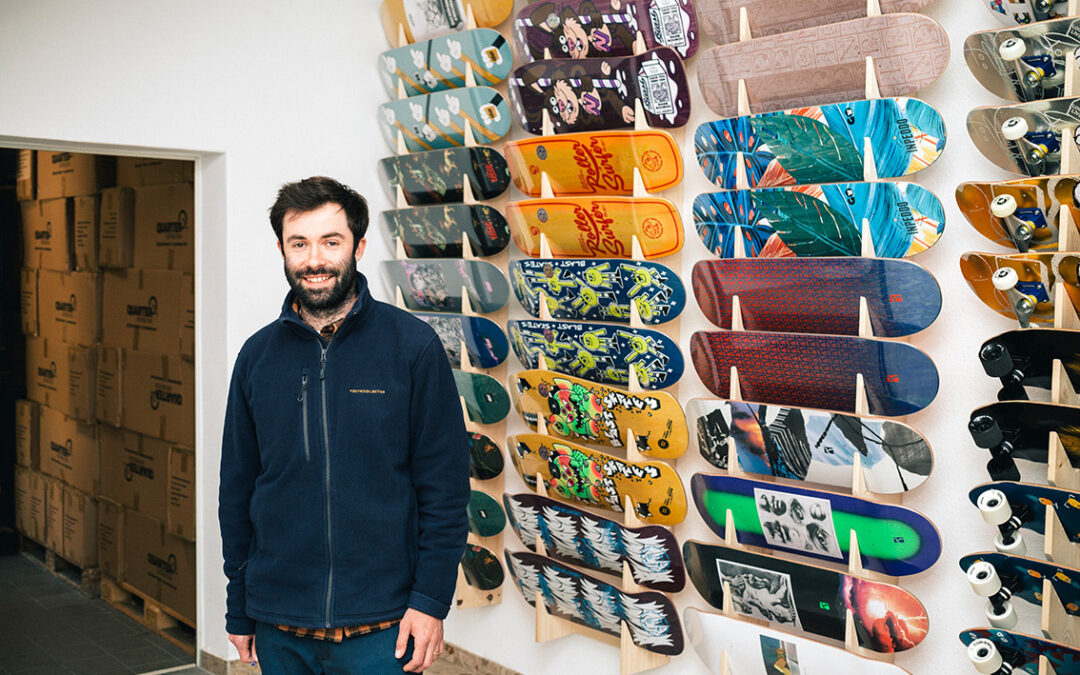A skateboard is a mystical object – to a lot of people it looks like magic that it stays under the feet when you jump with it. But even for skateboarders themselves, there are many myths surrounding the board. What is a quality characteristic? What does the price consist of? Where do the boards get produced? We have realized that there are some gaps in our knowledge, although the board is the central element of our passion. That’s why we asked an expert, Max Ritter from Quarter Distribution. They produce around 100k boards a year, which means they design the shapes and put the graphic on but the boards get pressed somewhere else. You see, we’re already fully in the topic.
Before we get into it, when we normally talk about skateboards, we have the decks from core brands in mind (which will be called professional boards in this article, not to be confused with pro boards). But if you look at the skateboard production in general, you also have complete boards (for beginners), cruisers and longboards. And these actually make up a much larger proportion.
What is the ratio?
Skateboards for professionals are a distant second. If you go to Walmart in America, they have shelfs full of completes. And every discount supermarket in Germany has a promotion with skateboards at some point. It feels like every child has a skateboard at home, but how many really stick with it? The core scene is quite a niche. That’s why complete boards and longboards have a huge market share compared to individual decks.
What makes a high-quality board?
High-quality boards are made from Canadian maple, from the region around the Great Lakes, on the border between America and Canada. There you have the ideal growing conditions. Harsh winters, optimum humidity and the trees grow very slowly and steadily. The wood is characterized by high tension combined with good flexibility, which is why it does not break easily. It is important for the quality that there are as few knots as possible. Then the boards should be pressed in individual molds. We use epoxy resin glue for our professional boards, which is particularly resilient, bonds the wood very well and has a low water content, unlike water-based glue. The more water in the glue and wood, the higher the chance that the boards will warp, especially if they are not stored properly. It is therefore important that the boards are allowed to rest for 3-4 weeks after they come out of the press and are processed further. So that they still lose moisture.
You have already mentioned many points that I would like to talk more in detail about. Let’s proceed step by step. Many boards are manufactured in China.
Wouldn’t it make sense to grow maple there instead of sending the wood around the world?
As I said, the climate in Canada is special. Relatively extreme temperature fluctuations, very humid climate. Maple from the border region of China and Russia is also used, but these are different climatic conditions and the trees grow a little faster and are not as good quality. Professional boards mainly use Canadian maple. However, cheaper wood is sometimes used for complete boards or dealers with dumping prices may sometimes use cheaper wood.
It is nearly impossible to get data about how many boards are produced in total worldwide since there is no central authority that collects it and there are a lots of manufacturers and most of them won’t share their numbers. But there are articles that claim that skateboarding has a contribution in maple deforestation. Nowadays some brands consider that and get wood from responsible managed forests or are part of programs like the Forest Stewardship Council (FSC). We’ll go deeper into that in a follow up article.
Click here for the full interview with Max Ritter at solo mag
Ein Skateboard ist ein magisches Objekt – für viele Menschen wirkt es wie Magie, dass es unter den Füßen bleibt, wenn man damit springt. Aber auch für Skateboarder selbst gibt es viele Mythen rund um das Brett. Was ist ein Qualitätsmerkmal? Woraus setzt sich der Preis zusammen? Wo werden die Bretter produziert? Wir haben festgestellt, dass es in unserem Wissen einige Lücken gibt, obwohl das Board das zentrale Element unserer Leidenschaft ist. Deshalb haben wir einen Experten gefragt, Max Ritter von Quarter Distribution. Sie produzieren etwa 100.000 Bretter pro Jahr, das heißt, sie entwerfen die Shapes und drucken die Grafik drauf, aber die Bretter werden woanders gepresst. Ihr seht, wir sind schon voll im Thema.
Wenn wir über Skateboards sprechen, denken wir normalerweise an die Decks der wichtigsten Marken (die in diesem Artikel als Profi-Boards bezeichnet werden, nicht zu verwechseln mit den Pro-Boards). Aber wenn man sich die Skateboard-Produktion im Allgemeinen ansieht, gibt es auch Komplettboards (für Anfänger), Cruiser und Longboards. Und diese machen tatsächlich einen viel größeren Anteil aus.
Wie ist das Verhältnis?
Skateboards für Profis sind weit abgeschlagen an zweiter Stelle. Wenn Sie in Amerika zu Walmart gehen, haben die Regale voll mit Komplettboards. Und jeder Discounter in Deutschland hatte irgendwann mal eine Aktion mit Skateboards. Gefühlt hat jedes Kind ein Skateboard zu Hause, aber wie viele bleiben wirklich dabei? Die Core-Szene ist eher eine Nische. Deshalb haben Komplettboards und Longboards im Vergleich zu einzelnen Decks einen großen Marktanteil.
Was macht ein hochwertiges Board aus?
Hochwertige Boards werden aus kanadischem Ahorn hergestellt, aus der Region um die Großen Seen, an der Grenze zwischen Amerika und Kanada. Dort herrschen die idealen Wachstumsbedingungen. Strenge Winter, optimale Luftfeuchtigkeit und die Bäume wachsen sehr langsam und gleichmäßig. Das Holz zeichnet sich durch eine hohe Festigkeit bei gleichzeitig guter Biegsamkeit aus, weshalb es nicht leicht bricht. Für die Qualität ist es wichtig, dass möglichst wenig Äste vorhanden sind. Anschließend sollten die Bretter in einzelne Formen gepresst werden. Für unsere Profi-Platten verwenden wir Epoxidharzleim, der besonders belastbar ist, das Holz sehr gut verleimt und im Gegensatz zu Leim auf Wasserbasis einen geringen Wassergehalt hat. Je mehr Wasser in Leim und Holz enthalten ist, desto größer ist die Gefahr, dass sich die Platten verziehen, vor allem, wenn sie nicht richtig gelagert werden. Deshalb ist es wichtig, dass die Bretter, nachdem sie aus der Presse kommen und weiterverarbeitet werden, 3-4 Wochen ruhen können. So verlieren sie noch Feuchtigkeit.
Du hast bereits viele Punkte angesprochen, auf die ich gerne näher eingehen möchte. Lasst uns Schritt für Schritt vorgehen. Viele Bretter werden in China hergestellt.
Wäre es nicht sinnvoll, dort Ahorn anzubauen, anstatt das Holz um die Welt zu schicken?
Wie ich schon sagte, ist das Klima in Kanada besonders. Relativ extreme Temperaturschwankungen, sehr feuchtes Klima. Es wird auch Ahorn aus den Grenzregionen Chinas und Russlands verwendet, aber dort herrschen andere klimatische Bedingungen, und die Bäume wachsen etwas schneller und sind nicht von so guter Qualität. Für professionelle Bretter wird hauptsächlich kanadischer Ahorn verwendet. Manchmal wird jedoch auch billigeres Holz für Completes verwendet, oder Händler mit niedrigeren Preisen verwenden manchmal billigeres Holz.
Es ist fast unmöglich, Daten darüber zu erhalten, wie viele Bretter insgesamt weltweit hergestellt werden, da es keine zentrale Behörde gibt, die diese Daten sammelt, und es viele Hersteller gibt, die ihre Zahlen nicht weitergeben. Es gibt jedoch Artikel, in denen behauptet wird, dass Skateboarding einen Beitrag zur Abholzung von Ahornbäumen leistet. Heutzutage berücksichtigen einige Marken dies und beziehen Holz aus verantwortungsvoll bewirtschafteten Wäldern oder nehmen an Programmen wie dem Forest Stewardship Council (FSC) teil. Wir werden in einem Folgeartikel näher darauf eingehen.
Klickt hier für das vollständige Interview mit Max Ritter im solo mag


Recent Comments